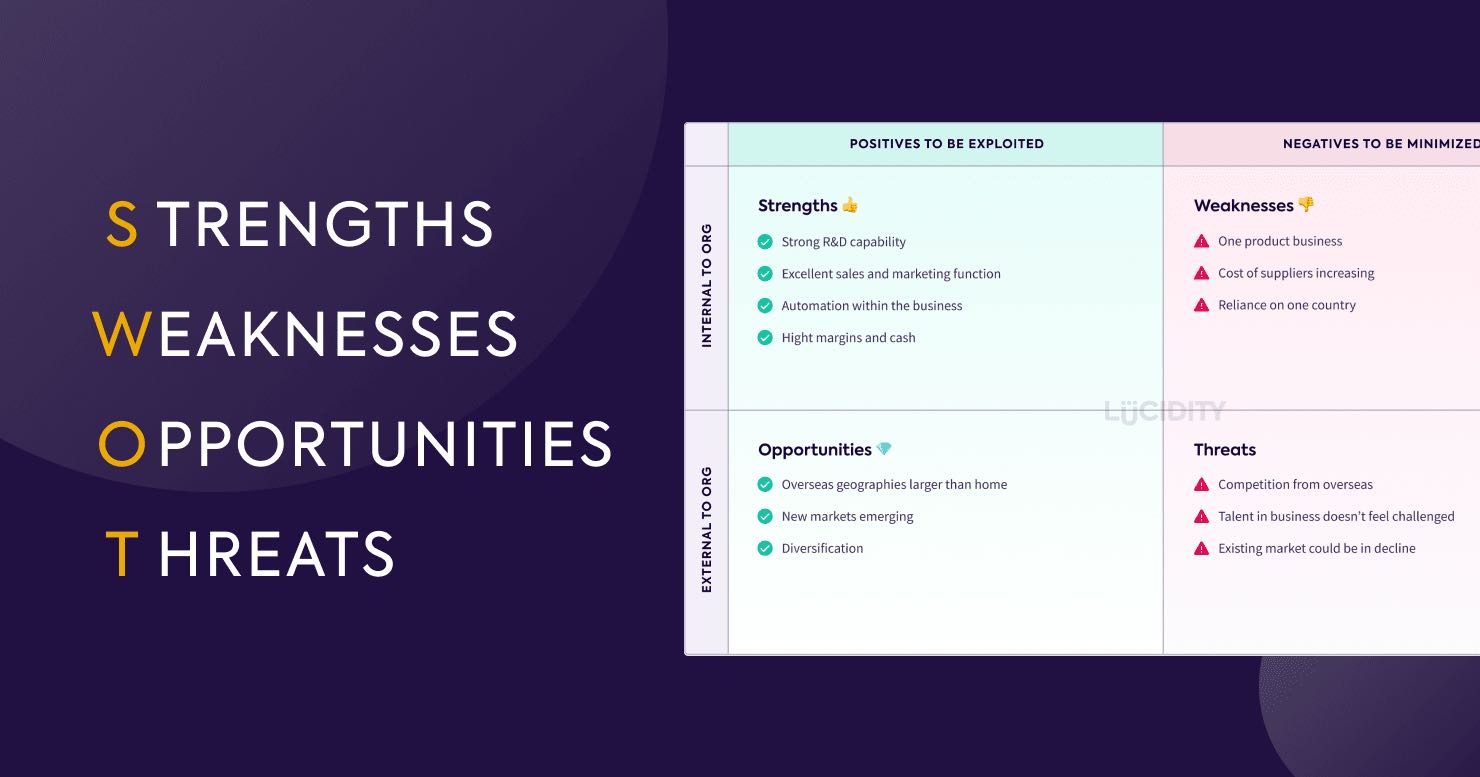SWOT stands for Strengths, Weaknesses, Opportunities and Threats. It is commonly displayed as a 2×2 matrix and is a popular tool used by businesses all over the world.
You’ve likely heard of SWOT, in fact it’s sometimes even used in personal development to look at an individual’s strengths, weaknesses, opportunities and threats.
This guide will provide you with everything you need to become an expert in SWOT Analysis. We’ve got information, frequently asked questions, video support, examples, and pointers on where you can complete your SWOT Analysis.
So without further ado, let’s begin our ultimate guide to the most famous strategic tool…
Beginner Guide to SWOT
Link: An Introduction to SWOT Analysis
If you have never encountered or heard of a SWOT Analysis before then this is the place to start. This in-depth introductory guide will provide you with all the answers to common questions about SWOT. It covers the following topics in detail:
- Definition of SWOT Analysis
- Imagery around SWOT Analysis
- When to use the tool
- Advantages and disadvantages
- Preparation and risks
- Complementary tools and frameworks
- Difference between SWOT and TOWS
- Common questions asked
- History of the tool and examples
So if you’re looking for a starter to get to know the SWOT Analysis in more detail there is no better place to begin. We’d recommend reading through this article before looking at the other resources in this ultimate guide. If you have already heard of SWOT you may be better off with some of the resources below.
Creating a SWOT Analysis
Link: 5 Steps to creating a SWOT Analysis
Completing a SWOT Analysis is a really effective way of mapping out factors that impact your strategic decision making, which is what this next resource is all about. If you’re looking for the steps on how to develop your own SWOT for you or your business then this is the article for you. It’s the best guide to creating a SWOT Analysis (ok, we’re biased… but it’s pretty damn good! 😎) This article will take you through the following:
- Step by step guide on how to develop a SWOT
- Example list of Strengths
- Example list of Weaknesses
- Example list of Opportunities
- Example list of Threats
- Key questions to ask yourself as you develop your SWOT
- Suggested ways to refine your SWOT
- Suggested next steps from your SWOT
- Methods of reusing your SWOT
There are a few options and templates for creating a SWOT matrix, as you’ll see later in this article, but if you’re looking to start from scratch then this is the resource for you!
Examples of SWOT Analysis
No matter what your company or industry is, it should be possible to find a suitable SWOT examples to get you thinking. There’s a number of resources to discover them, including many within Lucidity itself. Outside of the platform we’ve put together a number of potential SWOT examples that may be of use including:
Leisure Centre:
A look at what a SWOT may be like for an independent Leisure Centre.
Budget Supermarket:
Some examples around a budget supermarket in the UK.
The Body Shop:
What factors may be under consideration for The Body Shop in their SWOT.
Gym:
How an independent gym may be addressing their SWOT.
Mars Confectionary:
And to balance that gym example, here’s a tasty look at a SWOT for Malteasers
If you’re looking for a more in-depth discussion, here’s a look at a SWOT applied in the retail space, with some considerations about the conclusions you might draw. Of course, every SWOT is different, but looking at examples is a great way to stimulate discussion and get ideas for elements that may be impacting your own business positively and negatively.
SWOT Toolkits
There are a number of ways to create your own SWOT Analyses from DIY templates to software. Here are some of the common approaches:
Word & PowerPoint:
Creating a 2×2 in Word & PowerPoint is probably the most common way a SWOT is created for business planning. It’s effective because it’s quick, easy to build, and easy to edit. There are some disadvantages to this approach though. You may find many versions of the same framework and have difficulty with version control or consistency. It’s also often the case that this approach can lead to your SWOT being done, filed and forgotten…
Whiteboard:
Maybe less popular since Covid, but the classic approach of a whiteboard and post-it notes is probably the most popular way a SWOT has been run within a strategy workshop. The interactive nature of this approach works really well. You can break into teams to look at specific areas, it’s also easy to group and refine attributes. The disadvantage is where you put the outcomes, as you’re probably often back to Word, PowerPoint, or worse… email! Again, often filed and forgotten.
SWOT Software:
Hello! 👋 Yes, we’d have to mention this one… there’s a number of systems to create a SWOT Analysis. In the Lucidity strategy software you can create your SWOT and store it within your strategic plan. Disadvantages? We can’t think of any… 😂
SWOT Video Guide
Link: How to complete a SWOT Analysis video guide
If you prefer to watch a bitesized video rather than read a guide then you’re in luck! We’ve put together this short video that goes through a SWOT Analysis. In just under 2 minutes 30 seconds we cover:
- What is a SWOT Analysis
- Structure of a SWOT
- Considerations prior to completing SWOT
- Tips on how to complete SWOT
- Example Strengths
- Example Weaknesses
- Example Opportunities
- Example Threats
- Helpful questions
- Example refinements
So grab the popcorn and enjoy…🍿
SWOT Tips & Tricks
We can reveal a few tips around SWOT Analysis to help you out with the planning processes. Let’s start with a list of things you should do…
- Prepare well. Make sure you’ve spoken to customers and employees about the company.
- Balance your time and devote equal amounts to the S,W,O and T.
- Get a wide range of people from the company to feed in, you want team members who look inwards and outwards.
- It can help to get the views of someone external
To counter the above, here are some of the things you should avoid:
- Don’t make this the world’s longest list! Keep it high level to the important factors.
- Don’t be subjective, use data to support your reasoning
- Don’t do the SWOT and ignore it – take key actions, make decisions using it
We’ve also gathered a few quotes from strategy consultants and experts on SWOT… 🤔
"SWOT is a great way to summarise the key points from an external and internal analysis and provides a great platform to agree objectives and a suitable strategy."
René Moolenaar, Senior Lecturer at University of Sussex
"The simplicity of SWOT means it’s easy to rush it and not get the real value. A comprehensive and discussed SWOT can really alter your strategic decisions. Spend time on it, openly discuss the different areas, and use it as a way to capture conclusions from your other frameworks like PESTLE or Five Forces. Once done you can move on to developing tangible actions…"
Mike Fahey
"For me a SWOT Analysis is not the answer in itself is what you do with it that counts so Weaknesses become Strengths and Threats Opportunities. It’s a living document."
Nigel Allman, Ashton Consulting
"Recognise, invest in & protect your Strengths. It’s good for a CEO to spend time in the Weaknesses box because you can deal with those issues quicker than a manager can, some of those things can be legacy issues that are quite thorny to resolve. For Opportunities, it’s all about choosing which ones to focus on and – just as important – which ones not to focus on… and lastly remember, you can’t ignore the Threats box. Hope isn’t a strategy so you have to deliberately mitigate and avoid whatever is in there."
Tom Ricca-McCarthy
Taking SWOT Further: TOWS Analysis
TOWS Analysis stands for Threats, Opportunities, Weaknesses and Strengths, but it’s not just a simple 2×2. It’s an extension of SWOT that focuses on the relationships between each internal and external factor you list. There are a couple of articles to help…
Link: Introduction to TOWS Analysis
If you’ve not heard of TOWS before then this is the place to start. It’s a resource full of questions and answers around the model, explaining the following:
- Definition of TOWS
- Example diagram
- Advantages and disadvantages
- Preparation and advice on usage
Link: Guide to TOWS Analysis
This is the perfect guide on how to complete a TOWS Analysis, ideal if you’ve just finished your SWOT or if you’re starting from scratch and interested in how to develop your analysis. In this guide we go through:
- Example diagram
- Developing key actions
- Focusing on what is important
Finally, if you’d like to see an example then check out this TOWS Analysis for a bus company.
Although less common than SWOT, TOWS is a much more effective way to develop key actions for your business and should always be considered as a framework to use.
SWOT in Communication: SOAR Analysis
SOAR Analysis is a 2×2 matrix that is a very positive framework, focusing on Strengths, Opportunities, Aspirations and Results. SOAR is sometimes used as a way to communicate a SWOT with teams and people in a very positive manner, it’s also a way to map a set of Strengths and Opportunities into real world results.
Link: Introduction to SOAR Analysis
If you’ve not heard of SOAR before then this article will take you through the key facts about this framework including:
- Definition of SOAR Analysis
- Advantages and disadvantages
- Preparation and advice
Link: Guide to SOAR Analysis
If you’ve completed a SWOT or you’re aware of SOAR, then this guide will take you through how to develop your own SOAR Analysis in 5 steps. It includes everything you’d need including:
- Example factors to consider
- Helpful questions to ask at each stage
- Structure of the matrix
SOAR is a useful framework, but keep in mind you can’t ignore the negatives within a business. We’d always recommend you do a SWOT prior to completing a SOAR Analysis.
SWOT Checklist
It wouldn’t be an ultimate guide without a checklist, now would it? As we reach the end here’s a list of items you can tick off to ensure you get the most out of your SWOT Analysis.
✅ Ask customers for their input
✅ Involved a wide range of team members
✅ Don’t restrict feedback or be biased
✅ Create a positive and open feedback culture
✅ Refine your list so you have the key factors
✅ Examine the whole company – even the internal operations like Finance & HR!
✅ Be data driven in your analysis
✅ Create tangible actions from the work
✅ Communicate your findings
Summary
This concludes our guide to SWOT, we hope you’ve liked it!
There are hundreds of potential strategic frameworks but SWOT has stood out as the most famous and popular tool for many years. It’s a powerful, comprehensive, yet extremely simple framework that is accessible to all practitioners and professionals, regardless of their strategy experience.
Good luck with your SWOT!














